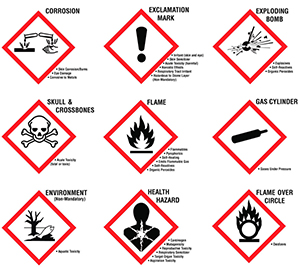The GHS is the Globally Harmonized System of Classification and Labeling of Chemicals.
The GHS, developed by the United Nations, is a system for standardizing and harmonizing the classification and labeling of chemicals according to their health, physical and environmental hazards.
Because it is not a regulation, no country is obligated to adopt all, or even part of it. At least 65 countries are implementing parts of the GHS. Below is some information that will demonstrate the value the GHS will bring to a chemicals management program.
What does the GHS do and how does it do it?
- Simplifies the international sale and transportation of hazardous chemicals.
- Makes workplace conditions safer for all employees exposed to chemical hazards.
The GHS provides consistent information in the form of pictograms, hazard statements and signal words such as “danger” to communicate chemical information in a logical and comprehensive way.
 Why do we need the GHS?
Why do we need the GHS?
Before the GHS, there was no harmonized system to classify, communicate and educate workers on the hazards associated with chemicals.
Without a harmonized approach, it was hard for governments to regulate and enforce hazard information, costly for companies who had to comply with different systems, and confusing for workers who needed to understand the hazards in order to work safely.
Where is the GHS used?
The GHS is used to make a globally consistent chemical Safety Data Sheet (SDS) which is the official hazard document that accompanies the chemical product wherever it goes.
The SDS contains accurate, detailed information about how to use and manage chemicals properly in the workplace. It standardizes the content and format, which makes it easier for workers to understand.
The U.S. adopted the GHS on March 26, 2012, but, unlike the European Union, did not include information on environmental toxicity such as persistence, and chronic and acute aquatic toxicity.
Impacts to your business
Questions to Consider:
- Are you still receiving MSDS’s that have not adopted the GHS system?
- Do you have a point person that manages chemicals and reviews SDS’s?
For help with any issue associated with chemicals, contact Amanda Cattermole at (415) 412 8406 or Amanda@cattermoleconsulting.com. We can help you develop powerful solutions to protect your company and brand reputation that result in safer products manufactured in cleaner supply chains.
Tips and Insights contains information to help you make informed chemicals management decisions. Each post highlights a particular topic and includes questions you may want to consider

